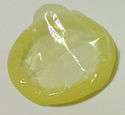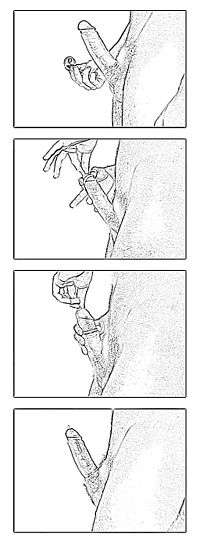Sexual Health/Barrier Birth Control and Spermicide
< Sexual HealthBarrier methods of birth control use a physical barrier to prevent the man's sperm from entering the woman's reproductive tract. Spermicide is often used with barrier methods to provide increased protection from pregnancy.
Condoms, both male and female, additionally provide protection from sexually transmitted diseases.
Male Condoms
Origins of Male Condoms
Condoms have been around for a lot longer than we think. From as early as 1000 BC, Egyptians used a linen cloth, Chinese used oil-soaked silk paper, and the Japanese even went so far as to use turtle shells and horn. The oldest condoms found were discovered in 1640 in Birmingham, England, made of fish and animal intestine. Condoms made of animal intestines were popular in England at that time, but were very expensive and often reused. The mass production of latex condoms began in 1844, but at the time were as thick as bicycle inner tubes and had a seam down the side. Manufacturing improved in the 1930s, making the single-use condom almost as thin and inexpensive as condoms found today.
Guidelines for male condom use


- Condoms should never be stored in hot places like car glove-compartments or wallets kept in pockets close to the body, as prolonged exposure to heat weakens latex.
- Sharp fingernails can damage condoms. In case of shaved or trimmed pubic hair extra care should be taken due to the stubble.
- Condoms are best put on the erect penis as soon as an erection is achieved and before any contact with the other person's body, and should always be put on before contact with a vagina or anus.
- Retracting the foreskin before putting on a condom maximizes mobility and reduces the risk of breakage during intercourse.
- Room needs to be left at the tip of a condom to hold semen. Most condoms have a reservoir tip that should be pinched while applying the condom to avoid trapping an air bubble which could burst later.
- Water-based sexual lubricants, such as KY Jelly, are safe for use with condoms, but oil-based lubricants weaken latex and may cause it to tear or develop holes. Lubrication can be used to reduce the abrasion on the condom during vaginal sex, and is virtually essential for anal sex. However lubrication should be used with care. One study has shown that additional lubrication may double the rate of condom slippage for vaginal sex and increase the rate of condom slippage for oral sex. The rate of condom slippage during anal sex however was reduced.
- Some condoms are designed specifically for anal sex. The material is slightly thicker, making these condoms less likely to tear than those designed for vaginal sex.
- Condoms should be discarded after the expiration date on the package. Even ones that seem fine past that date may be more likely to burst later.
- The penis should be withdrawn immediately after ejaculation, even if the erection can be maintained; leaving it in leads to needless risk.
- The base of the condom should be held during withdrawal to prevent the condom from slipping off.
- One's hands and penis should be washed before further physical contact with another person (including the sexual partner).
- Condoms are for single use only, and should never be reused.
- Condoms are available in special sizes for people who require larger or smaller ones.
- Practicing applying condoms alone in a well lighted place can help a man learn to apply it correctly before using them for sex.
Advantages of lubricating the inside tip of a condom
- Makes sex with a condom feel more like sex without a condom.
- A thicker condom may be used with no loss of sensation. (Very thick condoms could be made to be used this way.)
- This may encourage more to use condoms especially if it enables them to achieve orgasm with a condom on.
Possible disadvantages of lubricating the inside tip of a condom
- The condom may be more likely to break (especially if there is not adequate lubrication on the outside) because the penis may push to the end of the condom and stretch the tip to the breaking point (during ejaculation).
- If the condom breaks, the added sensation of the penis slipping inside the condom may make it more difficult for the penis to feel that the condom has broken.
- Lubrication mixed with pre-ejaculate, semen, or infected skin cells may leak around the open end of the condom, especially if too much lubrication is used on the inside.
- The condom may slip up and allow contact of skin or genital fluids, or at least the slipping may interrupt sex while the penis is dried, (sanitized), and a new condom put on.
General instructions for putting on a male condom

- Check the expiry date on the condom wrapper - Condoms have a printed expiry date and batch number. Do not use out of date condoms for sexual contacts, using them for practicing applying condoms alone especially by less experienced users is advised.
- Gently apply pressure to the condom wrapper to make sure it has a slight pillow-like quality to it, indicating air inside and proper and unbroken sealing. Otherwise air may have escaped from tear or punctures and the condom itself may be damaged as well.
- Exercising caution, open the foil (or plastic) wrapper along one side. Be careful not to damage the condom with sharp objects.
- If the condom is sticky or brittle, discard it and use another one.
- Press firmly together the tip of the condom to expel air that may be trapped inside the condom. Air pockets can cause the condom to burst. This tip is there to contain the discharge in ejaculation. Hold the condom by the tip.
- Ensure that the penis is fully erect — a condom may fall off the penis which is only partially erect.
- In case of an uncircumcised penis, retract the foreskin before applying the condom.
- Check that the condom is in the right direction to unroll down the penis and before unrolling put it on the tip of the penis. If you accidentally try to put it on the wrong way, discard it and start over with a new condom. Touching the wrong side of the condom with the penis can transfer bodily fluids, defeating its purpose.
- Unroll the condom over the shaft of the penis. Unroll it all the way. If it does not unroll, it is on the wrong way and you must start over with a new condom.
- Make sure the condom isn't loose or at risk of coming off.
- It may be essential to lubricate the outside of the condom to keep it from breaking, especially if lubrication was used on the inside.
- Do not allow the penis to go flaccid at any time while wearing or putting on the condom, or you will have to discard the condom.
Some men who feel a particular size condom is hard to put on because it is too small have reported that they partly unroll the condom, stretch it with both index fingers, insert the penis (asking their partner to expel air from the tip), remove fingers and unroll. This procedure is not recommended as one's fingernails can come in contact with the condom. Consider buying a larger condom, or practicing the approved method above.
Condom Size
Measure:
1. In order to accurately measure penis size, first you must have an erect penis (since penis size when flaccid is not an accurate measurement).
2. Measure Penis Length with a ruler or measuring tape. Position the ruler or measuring tape at the base of your penis (where it attaches to your body - make sure to press into the pubic bone as far as you can because fat can actually hide the length of your penis).
3. Measure Penis Girth with a piece of string (or something similar) or a soft measuring tape. Gently wrap the string one time around the thickest part of the shaft/body of your erect penis (yes, it still needs to be erect!).
Fit:
Small Condoms
Fits Length: 3 Inches - 6 Inches
Fits Girth: 4 Inches - 5 Inches
Examples: Any condom represented as small or snug.
Regular Condoms
Fits Length: 4 Inches - 7 Inches
Fits Girth: 5 Inches - 6 Inches
Examples: Any condom that does not specify a size.
Large Condoms
Fits Length: 5 Inches - 8 Inches
Fits Girth: 6 Inches - 7 Inches
Examples: Any condom represented as large or magnum.
X-Large Condoms
Fits Length: 6 Inches - 9 Inches
Fits Girth: 7 Inches - 8 Inches
Examples: Any condom represented as extra-large or XL.
Female Condoms
Guidelines for female condom use
- Because they are not made of latex, all lubricants, including oil-based ones, may be safely used with female condoms.
- Female condoms may be inserted up to 8 hours prior to sexual intercourse.
- Placement of female condoms does not require a male erection.
- Newer condoms made from nitrile are less likely to make rustling noises than the original polyurethane condoms.
- Any "rustling" can be counteracted by applying extra lubricant to the inside of the condom
- Applying lubricant to the inside of the condom also reduces the chances of the outer ring being pulled into the vagina during intercourse.
General instructions for placing a female condom
- The condom should be removed carefully from the packaging;
- The small inner ring should be squeezed closed;
- The inner ring should be pushed into the vagina, the outer ring remaining outside;
- The penis should be guided through the outer ring to ensure that it is not pushed aside.
- Before removing the condom, the outer ring should be squeezed and twisted (while the wearer is still lying down, if applicable) to ensure that semen does not leak out of the pouch. Pull to remove the condom.
Cervical Barriers
Diaphragms
Cervical Cap
Lea's Shied
Contraceptive Sponge
Spermicides
Spermicides significantly reduce the risk of pregnancy, but are not considered "highly effective" when used alone. They can, however, significantly increase the effectiveness of other methods. Concurrent use of condoms and spermicide theoretically results in failure rates as low as that of hormonal methods.
There are many different types of spermicides. Spermicidal foams may be inserted directly into the vagina. Films are also inserted into the vagina, but the couple must wait at least 15 minutes after insertion (to allow the film to dissolve) before beginning intercourse.
Spermicides are designed for specific uses. Those meant for use inside cervical barriers (creams and jellies) should not be used alone or with condoms, and vice versa.
If the spermicide causes irritation to the genitals of either partner, or if the woman develops a vaginal infection following spermicide use, the couple should use a different birth control method.